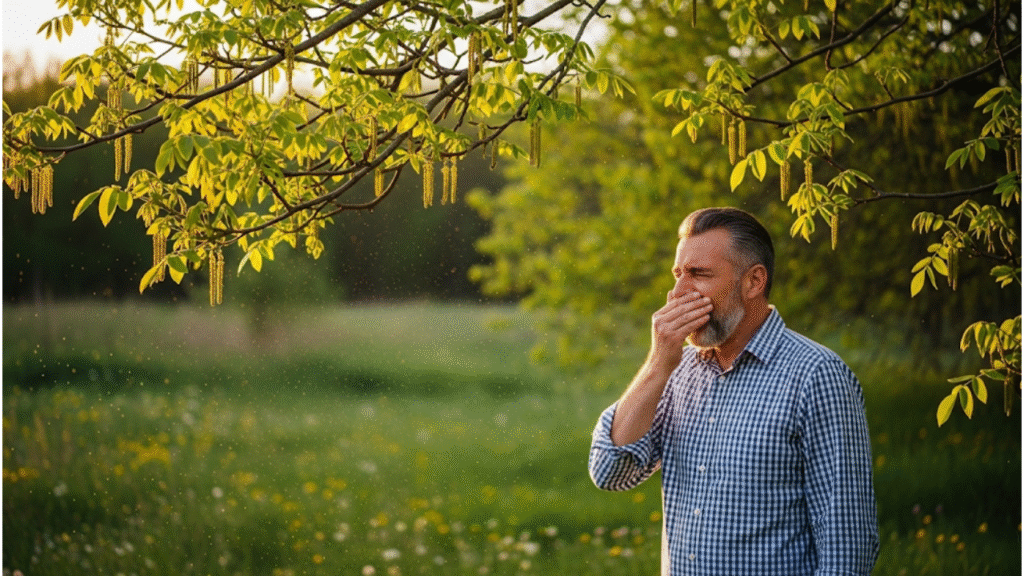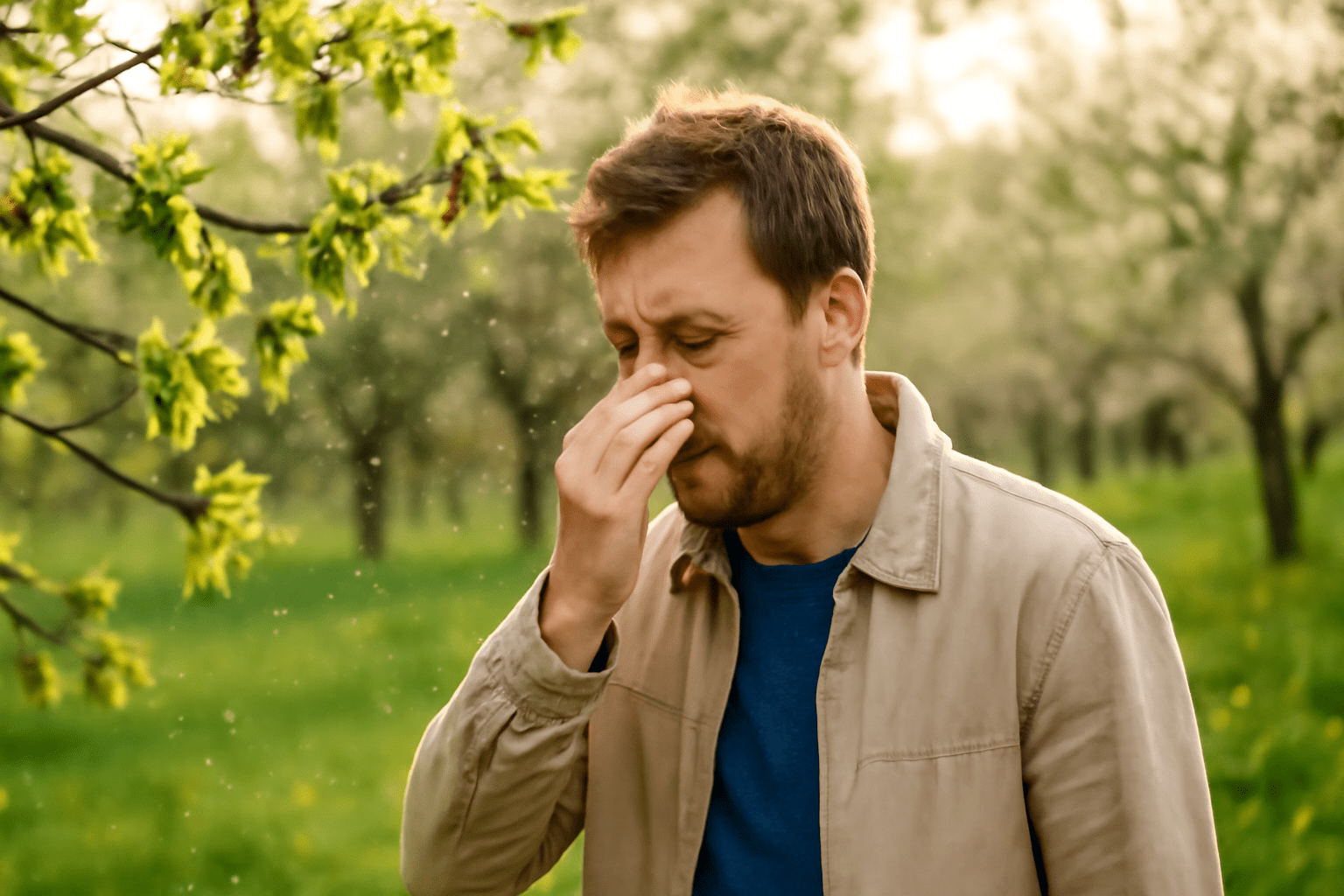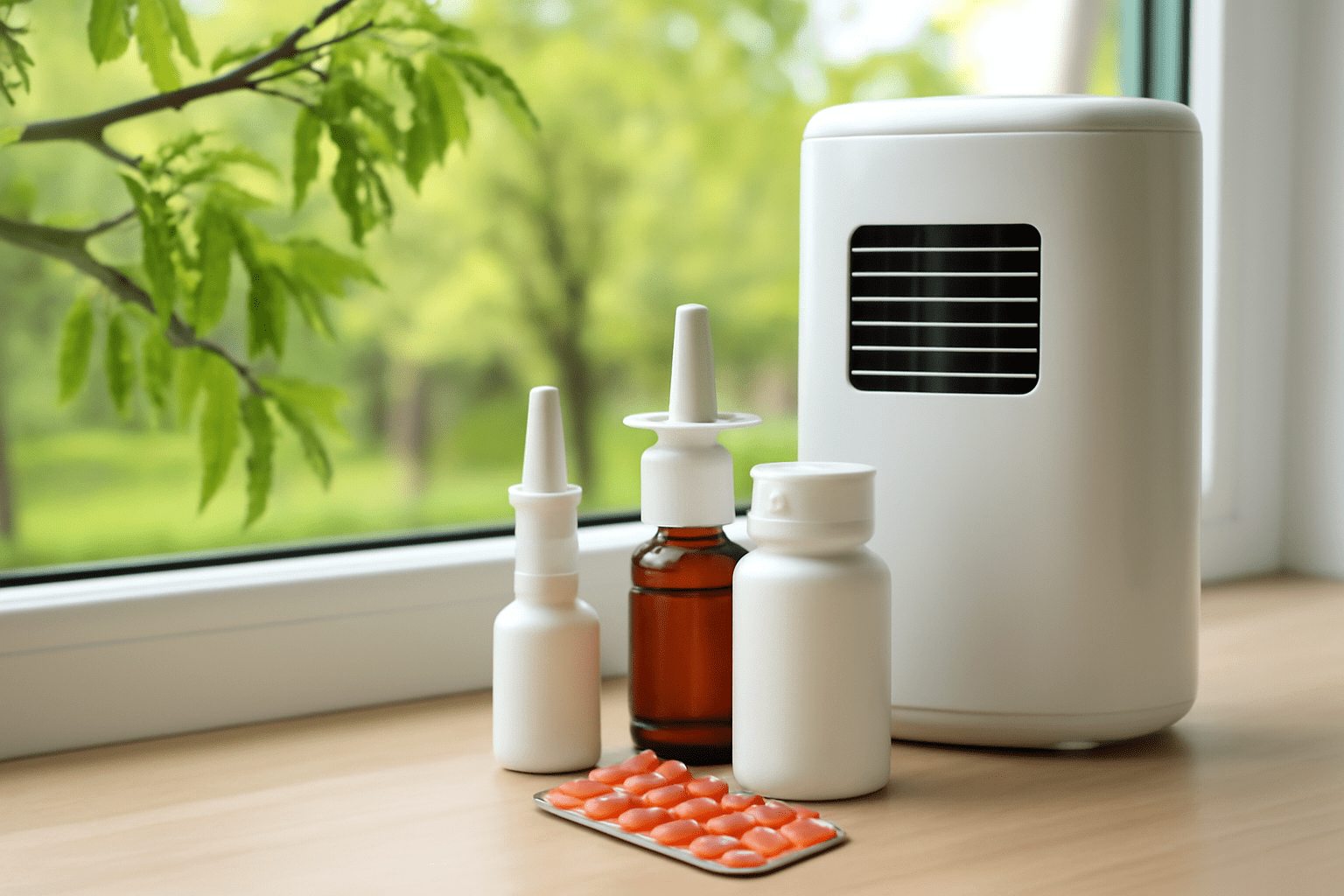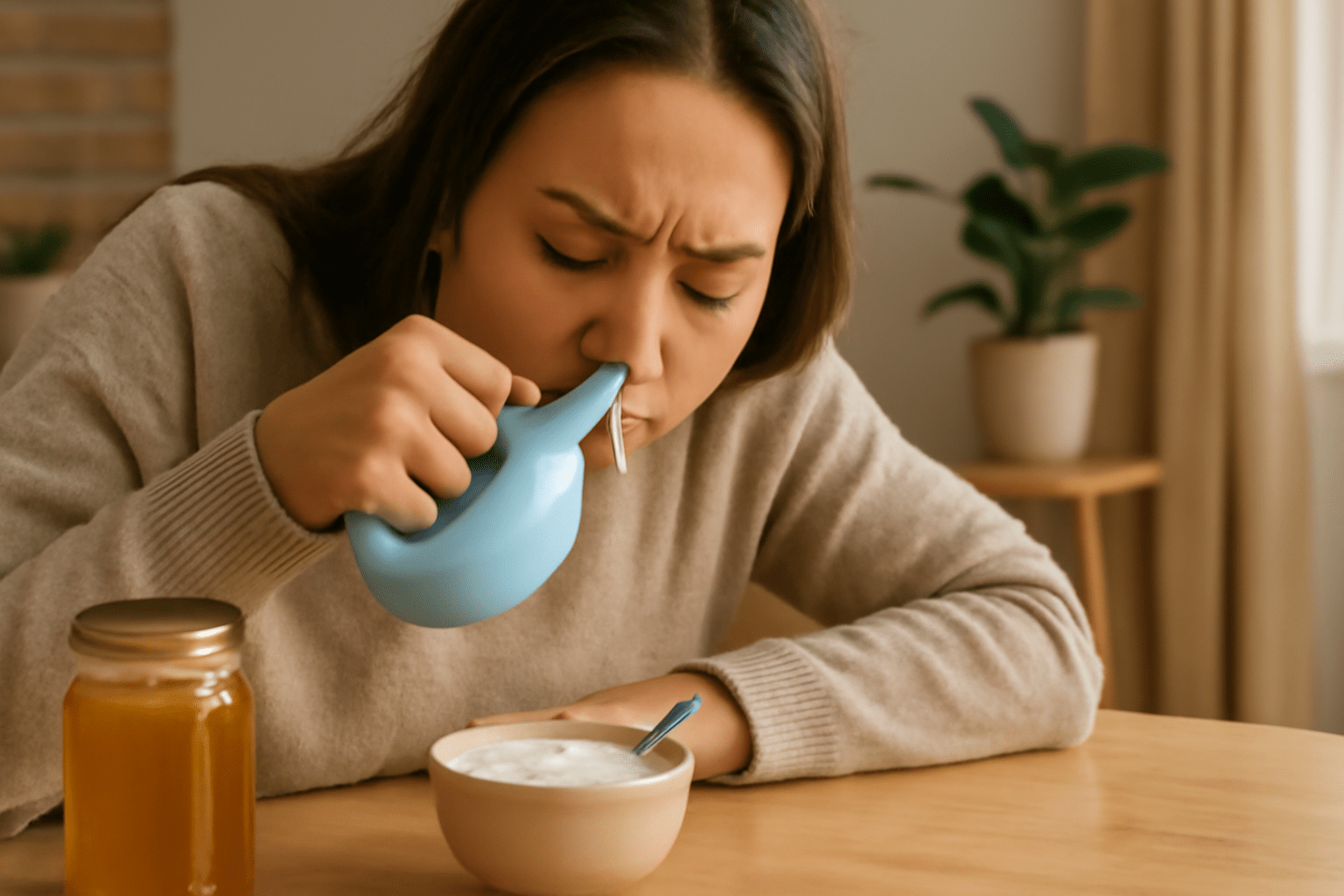
Walnut Tree Allergy: Symptoms, Causes, and Effective Treatment Options You Need to Know
Imagine stepping outside in the spring, only to find yourself suddenly sneezing, struggling to breathe, or battling itchy eyes. For many, these symptoms are more than just seasonal annoyance—they’re signs of a walnut tree allergy. 🌳
If you’ve ever wondered why certain trees make you feel miserable, you’re not alone. Walnut tree pollen is a hidden culprit for many allergy sufferers. As the walnut trees bloom, their pollen fills the air, triggering reactions in sensitive individuals. But what exactly causes these symptoms, and more importantly, how can you find relief?

In this article, we’ll dive deep into the symptoms, causes, and effective treatments of walnut tree allergy. Whether you’re experiencing mild discomfort or severe reactions, understanding how to manage this allergy can help you live more comfortably during allergy season. Keep reading to discover actionable tips and expert advice that will empower you to take control of your health. 🌱
Table of Contents
Toggle😊 Walnut Tree Allergy Symptoms: How to Identify Them 😊
If you’re unsure whether your allergy symptoms are caused by walnut trees, understanding the signs can help you quickly pinpoint the issue and take action. Walnut tree allergies often strike during the spring when these trees release their pollen into the air 🌸, but the symptoms can vary from person to person. Let’s take a look at the most common symptoms of a walnut tree allergy:
🌿 Respiratory Symptoms 🌿
- Sneezing & Coughing: Constant sneezing 🤧 and coughing 🤧 are telltale signs that something in the air is irritating your system. Walnut tree pollen can cause these reactions as it travels through your nasal passages and lungs. 🌬️
- Nasal Congestion: If you find yourself constantly blowing your nose 🤧 or experiencing a stuffy feeling that doesn’t seem to go away, walnut tree pollen might be the culprit. 🦠
- Wheezing or Shortness of Breath: In more severe cases, walnut tree pollen can trigger asthma-like symptoms, causing wheezing 😤 or difficulty breathing 🫁.
🌳 Skin Reactions 🌳
- Rashes & Hives: Some people may develop red, itchy rashes 🌸 or hives on their skin when exposed to walnut tree pollen. If you notice these after spending time outdoors near walnut trees, it’s likely an allergic reaction. 🌿
- Itchy Skin: Even if you don’t develop visible rashes, your skin might feel itchy or irritated. This is common with pollen allergies 🌾.
👁️ Eye Irritation 👁️
- Itchy or Watery Eyes: Another common symptom is itchy 👀, watery 💧, or red eyes 🔴. The pollen from walnut trees can cause allergic conjunctivitis, which leads to eye discomfort. 😣
- Swollen Eyes: In more severe cases, your eyes might become puffy or swollen 👁️ due to inflammation caused by the allergy. 💦
🍂 Gastrointestinal Symptoms (in Rare Cases) 🍂
- Stomach Cramps & Nausea: While less common, some people may experience nausea 🤢, stomach cramps 😖, or even vomiting 🤮 if they have a more severe walnut tree allergy. This is more likely to occur if they have a sensitivity to the pollen and certain foods 🍽️.

🤔 How to Differentiate Walnut Tree Allergy Symptoms from Other Allergies 🤔
- Seasonality: Walnut tree allergies tend to occur in the spring 🌸, around March to May 🌱, when pollen levels are at their highest. If you experience symptoms only during this time, it’s more likely to be walnut tree pollen. 🌳
- Other Allergens: If your symptoms are year-round or worsen during different seasons 🌦️, they might be linked to other allergens, like dust 🐾, mold 🍄, or pet dander 🐶.
By recognizing these symptoms and understanding their connection to walnut trees 🌳, you can better manage your allergy and find the right treatments 🩺. If you suspect that walnut tree pollen is the cause, it’s a good idea to consult with a healthcare provider for confirmation and guidance on managing your symptoms. 🌿
🌿 What Causes Walnut Tree Allergy? 🌿
Understanding the causes behind a walnut tree allergy is key to managing and preventing symptoms. Let’s break down the main factors that trigger this common allergy. 🌱
🌳 Walnut Tree Pollen: The Main Culprit 🌳
- Pollen Release: Just like many other trees 🌳, walnut trees produce pollen during their blooming season, which usually happens in the spring 🌸 (March to May). This pollen can travel for miles in the air 🌬️, making it easy for allergy sufferers to inhale and experience symptoms. 🤧
- How Pollen Affects You: When the walnut tree pollen enters the body, it triggers an immune system response 🛡️, which leads to the familiar allergy symptoms like sneezing 🤧, congestion 😷, and itchy eyes 👀. Your immune system mistakenly treats the harmless pollen as a threat 🚨, releasing histamines that cause inflammation. 🦠

🌱 Genetics: Are You Prone to Walnut Tree Allergies? 🌱
- Family History: If you have a family history of allergies—especially pollen allergies or asthma 🫁—you may be more likely to develop a walnut tree allergy. Your genetic makeup 🧬 plays a significant role in determining whether your immune system will overreact to walnut tree pollen. 🌿
- Cross-Reactivity: People with walnut tree allergies might also be sensitive to other tree pollen 🌲 (like birch or oak). This happens because certain allergens in walnut pollen are similar to those in other tree pollens, leading to a phenomenon called cross-reactivity 🔄.
🌍 Environmental Factors: The Role of Climate and Pollution 🌍
- Climate Change: Rising temperatures 🌞 and unpredictable weather patterns 🌦️ are contributing to longer allergy seasons. Walnut trees may start producing more pollen as the climate changes, increasing exposure to allergy sufferers. 🌡️
- Air Pollution: Studies suggest that air pollution 🌫️ can worsen pollen allergies. Pollutants in the air, like ozone 🌫️, can make the pollen more allergenic, causing more severe reactions for those already sensitive to it. 😷
By understanding the causes behind your walnut tree allergy 🌳, you can take steps to avoid triggers and better manage symptoms. Knowing that it’s the pollen causing these issues empowers you to seek out the right treatments 💊 and lifestyle changes 🧘 to improve your quality of life. 🌿
🩺 3. Diagnosing Walnut Tree Allergy: How to Confirm It 🩺
If you suspect you have a walnut tree allergy, getting a proper diagnosis is the first step towards effective treatment. Understanding the symptoms is important, but consulting a healthcare provider will help you confirm whether walnut tree pollen is the cause of your discomfort. 🌳

🧑⚕️ Consulting an Allergist 🧑⚕️
Why See an Allergist?: An allergist is a medical professional who specializes in diagnosing and treating allergies. If your symptoms are consistent with walnut tree pollen exposure, an allergist can help confirm whether this is the underlying cause. They can also recommend a treatment plan tailored to your specific needs. 💊
What to Expect During a Consultation:
- Your allergist will ask about your symptoms 🤔, when they occur 🕒, and any potential triggers 🌾.
- You may be asked about your family history of allergies 🧬 and whether you’ve had similar symptoms in the past. This helps them identify patterns that could suggest an allergy. 🔍
🧪 Tests Commonly Used to Diagnose Walnut Tree Allergies 🧪
- Skin Prick Test: This is one of the most common tests used to diagnose pollen allergies. A small amount of walnut tree pollen extract is placed on your skin, usually on your forearm or back. If you’re allergic, your skin will react by forming a small raised bump. This test is quick and provides immediate results. 🌿
- Blood Tests: If the skin prick test isn’t possible or you have sensitive skin 🧴, your doctor may recommend a blood test. This test measures the level of specific IgE antibodies in your blood 🩸, which are produced by your immune system in response to allergens like walnut tree pollen. It helps identify your sensitivity to walnut tree allergens. 🌳
- Patch Test (for skin reactions): If you experience skin irritation or rashes, a patch test might be used to pinpoint specific allergens. 🩹
⚠️ When to Seek Medical Advice ⚠️
If you’re unsure whether your symptoms are due to a walnut tree allergy or something else, it’s important to seek medical advice. In some cases, your symptoms may indicate a more severe allergic reaction or a different condition altogether. 🏥
- Severe Reactions: If you experience difficulty breathing 😤, swelling of the face or throat 🤐, or dizziness 😵, these could be signs of anaphylaxis—an emergency allergic reaction 🚨. Seek immediate medical attention if these symptoms occur.
- Persistent Symptoms: If your symptoms persist despite over-the-counter treatments 💊, or if they significantly impact your daily life 🕒, it’s important to consult an allergist for further evaluation and treatment. This helps ensure you aren’t dealing with an unrelated issue that could be affecting your health. 🧑⚕️
🧑⚕️ Importance of Getting a Professional Diagnosis 🧑⚕️
While you might be able to identify some symptoms on your own, it’s crucial to get a professional diagnosis. An allergist will help:
- Rule Out Other Conditions: Many allergies share similar symptoms with other health conditions like colds 🤧, sinus infections 😷, or asthma 🫁. A medical professional can rule out other causes and pinpoint whether walnut tree pollen is truly the problem.
- Personalized Treatment Plan: Getting the right diagnosis allows your allergist to tailor a treatment plan to your needs 💡, whether that includes medication 💊, lifestyle changes 🧘, or allergen avoidance strategies 🏞️.
Getting a proper diagnosis for your walnut tree allergy 🌳 will give you the confidence and tools you need to manage symptoms effectively and live comfortably during allergy season. 🌱
🌿Effective Treatment Options for Walnut Tree Allergy 🌿
Managing walnut tree allergy symptoms involves a combination of avoiding allergens, using medications, and considering long-term treatment options. Let’s explore some practical and effective treatment strategies. 💡

🚪 Avoidance Strategies: Limiting Exposure to Walnut Tree Pollen 🚪
The most effective way to prevent allergy symptoms is to minimize exposure to walnut tree pollen 🌳. Here are some helpful strategies to reduce your contact with allergens:
- Stay Indoors During Peak Pollen Times: Walnut tree pollen levels are highest early in the morning 🌅 and late afternoon 🌇. Try to stay indoors during these hours, especially on windy days when pollen is more likely to spread. 🌬️
- Keep Windows Closed: When pollen counts are high 🌿, keep windows and doors closed, particularly in the spring 🌸 when walnut trees are in bloom. This helps prevent pollen from entering your home 🏡.
- Use Air Purifiers with HEPA Filters: Investing in an air purifier with a HEPA filter can help remove pollen and other allergens from the air inside your home 🌬️. This is especially useful in bedrooms 🛏️ or areas where you spend a lot of time.
🛡️ Protective Measures 🛡️
In addition to avoiding exposure, these protective measures can help you manage symptoms when you do need to go outside:
- Wear a Mask During Outdoor Activities: Wearing a pollen mask 😷 when you go outside can help filter out walnut tree pollen, preventing it from entering your nose and mouth. This is particularly helpful when engaging in yard work 🌿 or outdoor activities 🌳.
- Wash Clothes and Shower After Time Outdoors: Pollen can cling to your clothes 👕, skin 🧴, and hair 💇♀️. After spending time outdoors, take a shower 🚿 and wash your clothes 🧼 to remove any lingering allergens.
💊 Medications 💊
If avoidance strategies aren’t enough to keep your symptoms in check, several medications can provide relief:
- Antihistamines:
- How They Work: Antihistamines block the histamine response that causes symptoms like sneezing 🤧, itching 😣, and congestion 🦠. They can be taken orally 💊 or in nasal spray form.
- Over-the-Counter Options: Common OTC antihistamines like Claritin (loratadine) 💊, Zyrtec (cetirizine) 🌿, and Allegra (fexofenadine) 🧴 are effective at reducing mild symptoms. They are generally non-drowsy, but some may cause mild sedation 💤.
- Prescription Alternatives: For more severe cases, your doctor may prescribe stronger antihistamines, such as Xyzal (levocetirizine), which can provide more robust symptom control. 💪
- Nasal Sprays:
- Steroid Nasal Sprays: Nasal corticosteroids like Flonase (fluticasone) 🌿 and Nasacort (triamcinolone) 🧴 are highly effective for reducing nasal inflammation and congestion. They can take a few days to start working, so it’s best to use them regularly during allergy season 🌸.
- How They Help: These sprays help to reduce inflammation in the nasal passages 🫁 and prevent further irritation, providing long-lasting relief from stuffy noses 👃 and sneezing 🤧.
- Eye Drops:
- If you suffer from itchy, red, or watery eyes 👀 due to walnut tree pollen, over-the-counter antihistamine eye drops like Visine-A can provide immediate relief 🌿. They reduce inflammation and soothe the eyes 💧.
- Decongestants:
- How They Help: Decongestants like Sudafed (pseudoephedrine) 💊 provide short-term relief from nasal congestion by narrowing blood vessels in the nasal passages. They are effective for reducing stuffy noses 👃 but should not be used for extended periods ⏳.
💉 Allergen Immunotherapy (Allergy Shots) 💉
For those who suffer from chronic walnut tree allergy symptoms, allergen immunotherapy (commonly known as allergy shots) is a long-term treatment option that may provide lasting relief. 🌱
- Overview of Allergy Shots: Allergy shots involve injecting small, gradually increasing doses of walnut tree pollen into the body 🩸 over time. This helps desensitize your immune system to the allergen 🌳, reducing the severity of allergic reactions in the future.
- Success Rates and Considerations: Allergy shots can take several months to begin working, and they require long-term commitment (often 3-5 years) ⏳. However, they offer a highly effective solution for those with persistent and severe symptoms. Success rates are generally high, with many patients experiencing significant symptom improvement after the treatment course ✨.
🌿 Choosing the Right Treatment for You 🌿
Managing walnut tree allergy symptoms involves a mix of prevention, symptom relief, and long-term treatment. Depending on the severity of your allergy, you may benefit from a combination of lifestyle changes 🌱, medications 💊, and even immunotherapy 💉. By working with a healthcare provider 🩺, you can develop a personalized plan to reduce symptoms and enjoy a more comfortable allergy season 🌳.
🌿 Natural Remedies and Lifestyle Adjustments for Walnut Tree Allergy Relief 🌿
While medications can provide effective relief 💊, many people also find that natural remedies 🌱 and lifestyle adjustments help manage their walnut tree allergy symptoms more holistically. Here are some natural approaches you can incorporate into your routine to support your allergy relief efforts. 🌳

🌸 Natural Remedies 🌸
🌊 Nasal Irrigation (Neti Pot) 🌊
- How It Works: Nasal irrigation is a popular natural remedy that involves using a Neti Pot 🏺 or saline spray to rinse out allergens like walnut tree pollen 🌳 from the nasal passages. By flushing the sinuses with saline water 💧, you help clear out pollen, mucus, and other irritants, reducing congestion and irritation. 😤
- Benefits: This method provides immediate relief from nasal congestion 🤧 and helps soothe the inflamed nasal passages 🌿. It’s especially effective when pollen levels are high during allergy season 🌸. Be sure to use sterile or distilled water 🚰 to avoid infection.
🍯 Honey and Probiotics 🍯
- Local Honey: Some studies suggest that consuming local honey 🍯 may help build tolerance to local allergens 🌾. By eating honey produced by bees 🐝 that gather pollen from the area, you’re potentially exposing your immune system to small amounts of the allergen, which can help reduce sensitivity over time. 🌱
- Probiotics: Probiotics are beneficial bacteria 🦠 that support a healthy gut. Research shows that a healthy gut can help modulate the immune system and potentially reduce allergic reactions. Consider adding probiotic-rich foods like yogurt, kefir, and fermented vegetables 🥬 to your diet.
🥗 Dietary Considerations 🥗
🍴 Anti-Inflammatory Foods 🍴
Diet plays a crucial role in supporting immune health 🧑⚕️ and reducing allergy symptoms 🌱. Focus on foods that can help decrease inflammation and strengthen your body’s natural defense system:
- Omega-3-Rich Foods: Foods like salmon 🐟, flaxseeds 🌾, and walnuts (yes, ironically!) are rich in omega-3 fatty acids, which help fight inflammation and support overall immune health. 💪
- Antioxidants: Incorporate fruits 🍓 and vegetables 🥦 like berries, spinach, and kale, which are high in antioxidants. These nutrients help protect your cells from damage caused by free radicals and reduce the overall inflammatory response in your body.
🧘♀️ Mind-Body Practices 🧘♀️
🌬️ Yoga and Breathing Exercises 🌬️
- Yoga: Gentle yoga practices 🧘♀️ can help reduce stress, improve circulation, and promote relaxation, all of which can help manage allergy symptoms. Poses like forward bends and child’s pose can help open up your airways and relieve sinus pressure. 🧘♂️
- Breathing Exercises: Practices like pranayama (yogic breathing) 🌬️ can help clear the sinuses and improve airflow. By focusing on deep, controlled breathing 🧘♀️, you can calm your nervous system 🧠 and reduce the stress that often accompanies allergy symptoms. 😌
🌿 Stress-Reduction Techniques 🌿
Chronic stress 😰 can worsen allergy symptoms, so incorporating stress-reduction techniques is essential. Meditation 🧘, deep breathing 🌬️, and mindfulness can all help lower your body’s response to allergens, making it easier to manage symptoms. 🌿
🌿 A Holistic Approach to Allergy Relief 🌿
Natural remedies 🌿 and lifestyle adjustments 🌱 can play a valuable role in managing walnut tree allergies, particularly when combined with traditional medical treatments 💊. By focusing on improving your overall health with anti-inflammatory foods 🥗, stress management 🧘, and immune support 🦠, you can create a more balanced and resilient response to allergens 🌳. Remember, while these remedies can be beneficial, it’s important to consult with a healthcare provider 🩺 to ensure a comprehensive, tailored approach to your allergy management. 🌱
🌿 Walnut Tree Allergy Prevention Tips: Staying Symptom-Free 🌿
Preventing walnut tree allergy symptoms requires preparation and vigilance. With the right strategies, you can reduce your exposure to allergens and enjoy the spring season without constant discomfort. Let’s dive into some seasonal preparations and home and garden tips to keep walnut tree allergy symptoms at bay. 🌱

🌱 Seasonal Preparations: Preparing for Allergy Season 🌱
- Monitor Pollen Counts: Stay informed about local pollen levels 📱 through online resources or weather apps. When pollen counts are high, plan to stay indoors, especially during peak release times in the early morning 🌅 and late afternoon 🌇.
- Keep Windows Closed: During the allergy season 🌸, it’s crucial to keep windows closed to prevent pollen from entering your home 🏡. Use air conditioning ❄️ with a HEPA filter to help purify the air indoors.
- Prepare Allergy-Proofing Supplies: Stock up on allergy medications 💊 like antihistamines, nasal sprays 💧, and eye drops 👁️ ahead of time. Having them readily available will allow you to manage symptoms as soon as they start.
- Schedule an Allergy Shot: If you’re considering long-term relief 💉, talk to your doctor about starting allergen immunotherapy (allergy shots) before the season begins. This can help desensitize your body to walnut tree pollen 🌳 and reduce symptoms over time.
🏡 Home and Garden Tips 🏡
- Keep Walnut Trees at a Distance: If possible, avoid planting walnut trees 🌳 near your home or living areas. If you already have walnut trees in your yard, consider trimming them back ✂️ or relocating garden spaces away from trees to reduce exposure.
- Remove Walnut Tree Debris from Your Yard: Fallen walnut tree pollen 🌿, nuts 🌰, and leaves 🍂 can continue to release allergens even after the pollen season has passed. Regularly rake and remove fallen debris from your yard, patio, or garden 🌼 to limit the spread of allergens.
- Create an Allergy-Friendly Outdoor Space: If you love spending time outdoors 🌳, consider creating a small, protected area in your yard 🏡, away from walnut trees. Use screens or netting 🪶 to create a barrier and reduce pollen exposure.
🏠 Indoor Allergy-Proofing 🏠
- Use Air Purifiers: Set up air purifiers 🌬️ with HEPA filters in high-traffic areas of your home, particularly bedrooms 🛏️ and living rooms 🛋️. This will help trap pollen and other airborne allergens.
- Clean Regularly: Pollen can settle on surfaces indoors 🏠. Regularly vacuum with a HEPA filter, wipe down surfaces with a damp cloth 🧽, and wash bedding 🛏️ and curtains frequently to remove any lingering allergens.
- Change HVAC Filters: If your home has air conditioning 🌬️ or heating, replace the filters with high-efficiency particulate air (HEPA) filters to reduce the amount of pollen circulating in your home 🏡.
By taking these preventative steps 🌱, you can significantly reduce your exposure to walnut tree pollen 🌳 and other allergens, keeping allergy symptoms at bay during the peak pollen season. With some preparation and adjustments, you’ll be better equipped to handle walnut tree allergies and enjoy the outdoors 🌳!
🌿 How Walnut Tree Allergy Affects Daily Life 🌿
Living with a walnut tree allergy can be challenging, especially during peak allergy season. The symptoms, such as sneezing 🤧, congestion 😷, and itchy eyes 👀, can significantly impact your daily routine and overall quality of life. Here’s how walnut tree allergy can affect different aspects of life and some tips for managing its impact. 🌱

🏠 Impact on Work, School, and Activities 🏠
- Reduced Productivity: Persistent allergy symptoms like nasal congestion, headaches 🤕, and fatigue 😴 can make it difficult to focus and stay productive at work or school 🎓. You may find it harder to concentrate on tasks or participate in meetings 🗣️ and discussions. 🤧
- Disrupted Routine: The constant need to manage symptoms may force you to adjust your daily schedule 🕒. You might need extra time for rest 🛏️ or to take allergy medications 💊, which can interfere with your regular activities and commitments 📅.
- Limited Outdoor Activities: Walnut tree pollen tends to peak during the spring 🌸, a time when many people want to enjoy outdoor activities like gardening 🌻, hiking 🥾, or sports 🏀. For allergy sufferers, going outdoors can be a challenge, as exposure to pollen can worsen symptoms and cause discomfort 😓.
😓 Psychological Impact 😓
- Stress and Anxiety: Chronic allergies can lead to stress and anxiety 😔, especially if symptoms are persistent or severe. The discomfort of dealing with sneezing 🤧, congestion, and itchy eyes 👁️ day after day can take a toll on mental well-being 🧠.
- Fatigue: Constantly battling allergy symptoms can lead to chronic fatigue 😴. This is especially true if you’re not getting restful sleep 💤 due to nighttime congestion or other symptoms. Feeling tired and run down can impact both your productivity and mood 😔.
- Frustration with Limited Relief: If over-the-counter medications 💊 or home remedies 🏡 don’t seem to work, it can be frustrating to feel like you have no control over your symptoms. This may lead to a sense of helplessness or discouragement 😞, especially when trying to manage your allergies on your own.
🌍 Social and Environmental Factors 🌍
- Social Life: Allergies can also affect your social life 🥳. Attending outdoor events like barbecues 🍖, parties 🎉, or festivals 🎶 can become stressful if you’re constantly worrying about your symptoms flaring up. You might find yourself declining invitations or limiting social interactions due to fear of triggering allergy symptoms.
- Traveling: If you’re planning a trip ✈️, walnut tree pollen can complicate matters. Traveling to areas with high pollen counts can worsen your symptoms, especially if you’re not prepared with medication or other preventative measures. 🌍
- Workplace Challenges: If you work in an environment with poor air quality 🌫️ or one where you’re exposed to outdoor allergens frequently 🏢, it may be harder to manage your symptoms. Some workplaces may not have allergy-friendly accommodations 🏢, making it tough to maintain productivity and comfort.
🛑 Managing the Impact of Walnut Tree Allergy 🛑
While walnut tree allergies can impact various aspects of daily life, there are strategies to help minimize their effects:
- Time Management: Create a routine 🗓️ that allows for extra rest 🛏️ and downtime. Plan allergy-friendly activities, like indoor hobbies 🎨, during peak pollen times. 🕒
- Medication and Treatments: Use prescribed or over-the-counter medications 💊 to keep symptoms under control. Allergy shots 💉 (immunotherapy) can provide long-term relief for those with chronic symptoms.
- Outdoor Limitations: Limit outdoor activities to the times of day when pollen levels are lower 🌧️, typically after rainfall 🌦️ or later in the evening 🌙.
- Mindfulness and Stress Relief: Practice relaxation techniques like deep breathing 🌬️, meditation 🧘♂️, or yoga 🧘♀️ to reduce the stress caused by chronic allergies.
By understanding how walnut tree allergies affect daily life 🌱, you can better manage the condition and make adjustments to minimize its impact on your work 💼, social life 🥳, and overall well-being 🌿.
🌿 When to See an Allergist or Doctor: Recognizing Red Flags 🌿
While most walnut tree allergy symptoms can be managed with over-the-counter treatments 💊 and lifestyle changes 🌱, there are certain red flags 🚨 that indicate it’s time to seek medical attention. It’s important to recognize these warning signs early to prevent serious complications and ensure you’re getting the proper care. Here’s when you should see an allergist or doctor 🩺:

⚠️ Severe Allergic Reactions (Anaphylaxis) ⚠️
Anaphylaxis is a rare but serious allergic reaction that can occur in some individuals with walnut tree allergies 🌳. While this extreme reaction is uncommon, it’s essential to be aware of the signs and know when to seek emergency care 🆘.
What is Anaphylaxis?
Anaphylaxis is a severe, rapid-onset allergic reaction that can be life-threatening. It can cause your throat to swell, making it difficult to breathe 🌬️, and may also lead to a sharp drop in blood pressure 💉, causing dizziness or even loss of consciousness. 🧠
Key Signs to Look Out For:
- Swelling: Swelling of the face, lips, throat, or tongue 👄 is a significant sign of anaphylaxis. This can block the airways, making breathing difficult. 😷
- Difficulty Breathing: If you notice wheezing 😤, shortness of breath 🫁, or a tight feeling in your chest 💨, it could be a sign that the allergy is affecting your respiratory system severely.
- Dizziness or Fainting: Anaphylaxis can lead to dizziness or fainting 🥴 due to a rapid drop in blood pressure. This is a medical emergency 🚨, and you should seek immediate help.
- Other Symptoms: Additional signs of anaphylaxis may include nausea 🤢, vomiting 🤮, hives 🐝, or a feeling of extreme weakness. These symptoms may develop quickly, often within minutes of exposure to the allergen. 🕒
What to Do:
If you or someone else shows signs of anaphylaxis, call 911 immediately 📞 and use an epinephrine auto-injector (EpiPen) if available. Anaphylaxis requires urgent medical intervention to prevent serious complications. 🏥
⚠️ Chronic Symptoms ⚠️
If you experience persistent allergy symptoms that don’t improve with standard treatments or over-the-counter medications 💊, it may be time to consult a healthcare provider. Chronic or untreated allergies can lead to ongoing discomfort 😓 and more serious health issues.
When Symptoms Don’t Improve:
- Prolonged Nasal Congestion: If you’re unable to breathe freely through your nose 👃 or your congestion lasts for weeks despite using nasal sprays 💧 or antihistamines 💊, it may indicate that your allergies are not well-managed.
- Constant Sneezing or Coughing: If you find yourself sneezing 🤧 uncontrollably or coughing regularly, even with medication, it could be a sign that your allergies need more targeted treatment 🧑⚕️.
- Worsening Asthma or Breathing Issues: If your asthma or other respiratory conditions are exacerbated by your allergy symptoms, it’s important to consult a doctor 🩺 for stronger treatment options. 🚶♂️
When to Seek Medical Advice:
If you’re struggling to control your symptoms despite trying various medications and avoidance strategies 🌱, it’s time to see an allergist. They can perform more detailed tests 🧑🔬 and recommend stronger treatments 💉, such as allergy shots (immunotherapy).
Sinus Infections or Complications:
Chronic allergic rhinitis (nasal inflammation) 🌿 can lead to secondary infections like sinusitis 🦠. If your symptoms are accompanied by facial pain 😖, fever 🤒, or green/yellow nasal discharge, you may have an infection that requires medical treatment 🏥.
By recognizing the signs of severe reactions or chronic symptoms 🌿, you can avoid serious complications and seek timely medical care. An allergist can help you manage your walnut tree allergy effectively, ensuring that you can enjoy life with fewer disruptions. 🌳
🌿 Final Thoughts 🌿
Dealing with walnut tree allergies 🌳 can be challenging, especially during peak pollen season 🌸. However, with the right knowledge 📚 and proactive steps 💪, you can manage your symptoms and improve your quality of life. Whether it’s through avoidance strategies 🚪, medications 💊, or natural remedies 🌿, there are various ways to reduce your exposure to allergens and find relief. 🌱
Understanding the causes behind your walnut tree allergy 🧠 and recognizing the symptoms early on is key to managing the condition effectively. It’s also important to consult with an allergist 🩺 if you experience severe reactions or chronic symptoms that don’t improve with basic treatments. 🧴

Remember, you’re not alone—many people share your struggle, and there are plenty of resources 📲 to help you navigate this allergy season. By following the prevention tips 🌱, utilizing treatment options 💉, and making small lifestyle adjustments 🧘, you can enjoy a more comfortable, symptom-free life. 🌿
Stay informed 🧑⚕️, stay prepared 🛠️, and take control of your walnut tree allergy 🌳. With the right tools and a proactive mindset 💭, you can enjoy the outdoors 🌞 and live your daily life with fewer disruptions. 🌳
Frequently Asked Questions (FAQ)
What are the common symptoms of a walnut tree allergy?
Walnut tree allergy symptoms typically include sneezing, nasal congestion, coughing, itchy or watery eyes, and skin rashes. In some cases, it can also cause difficulty breathing or wheezing, particularly in individuals with asthma or more severe allergies.
Can walnut tree pollen trigger asthma attacks?
Yes, walnut tree pollen can trigger asthma attacks in sensitive individuals. It can cause wheezing, shortness of breath, and tightness in the chest. If you have asthma, it’s essential to manage your allergy symptoms effectively to prevent asthma flare-ups.
How can I avoid walnut tree pollen during allergy season?
To limit exposure to walnut tree pollen, stay indoors during peak pollen times (early morning and late afternoon), keep windows closed, and use air purifiers with HEPA filters. When outside, wearing a pollen mask and washing your clothes afterward can help reduce exposure.
What is the best treatment for walnut tree allergy symptoms?
The best treatment includes using antihistamines for relief from sneezing and congestion, nasal sprays to reduce inflammation, and eye drops for itchy, watery eyes. For long-term relief, allergy shots (immunotherapy) can help desensitize your body to walnut tree pollen.
Can eating walnuts worsen walnut tree allergies?
Walnut tree allergies are typically triggered by pollen, not by consuming the nuts themselves. However, some people may experience a reaction if they have oral allergy syndrome (OAS), where certain fruits or nuts, including walnuts, cause mild symptoms like itching in the mouth or throat.
How do I know if I have a walnut tree allergy or just a common cold?
Walnut tree allergies usually occur during spring when pollen levels are high, causing symptoms like sneezing, nasal congestion, and itchy eyes. Unlike a cold, allergies don’t typically cause a fever or body aches. If symptoms persist and worsen with pollen exposure, it’s likely an allergy.
Is walnut tree allergy seasonal or permanent?
Walnut tree allergies are seasonal, typically occurring in spring when the trees release pollen. The symptoms usually subside once the pollen count decreases, but people with severe allergies may experience persistent symptoms each year during the same period.
When should I see a doctor for my walnut tree allergy?
You should see a doctor if your symptoms don’t improve with over-the-counter treatments, if you experience severe reactions like difficulty breathing or swelling, or if you’re unsure about your symptoms. A healthcare provider can help with diagnosis and offer more targeted treatments like allergy shots or stronger medications.
